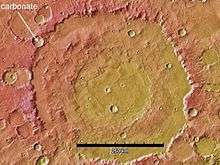Huygens (crater)
 | |
| Planet | Mars |
|---|---|
| Coordinates | 14°00′S 304°24′W / 14.0°S 304.4°WCoordinates: 14°00′S 304°24′W / 14.0°S 304.4°W |
| Diameter | 456 km |
| Eponym | Christiaan Huygens |
Huygens is an impact crater on Mars named in honour of the Dutch astronomer, mathematician and physicist Christiaan Huygens.
The crater is approximately 456 km (283 mi) in diameter and can be found at 304.4°W 14.0°S,[1] in the Iapygia quadrangle.
Scientists were delighted to see branched channels in pictures taken with spacecraft that were sent in orbit around Mars. The existence of these channels is strong evidence that much water once flowed on the surface of the planet. Simple organisms may have once lived where water once was. An excellent group of these channels is shown in the picture below from the rim of Huygens taken with THEMIS.
Carbonates (calcium or iron carbonates) were discovered in a crater on the rim of Huygens. The impact on the rim exposed material that had been dug up from the impact that created Huygens. These minerals represent evidence that Mars once had a thicker carbon dioxide atmosphere with abundant moisture. Carbonates of these kinds only form when there is a lot of water. They were found with the Compact Reconnaissance Imaging Spectrometer for Mars (CRISM) instrument on the Mars Reconnaissance Orbiter. Earlier, the instrument had detected clay minerals. The carbonates were found near the clay minerals. Both of these minerals form in wet environments. It is supposed that billions of years ago Mars was much warmer and wetter. At that time, carbonates would have formed from water and the carbon dioxide-rich atmosphere. Later the deposits of carbonate would have been buried. The double impact has now exposed the minerals. Earth has vast carbonate deposits in the form of limestone.[2]
Images
- Huygens Crater.
 Huygens Crater - place where carbonate was discovered is noted.
Huygens Crater - place where carbonate was discovered is noted.- Branched valleys on the rim of Huygens Crater, as seen by THEMIS.
 Possible dikes on floor of Huygens Crater, as seen by HiRISE under the HiWish program.
Possible dikes on floor of Huygens Crater, as seen by HiRISE under the HiWish program.
Why craters are important
The density of impact craters is used to determine the surface ages of Mars and other solar system bodies.[3] The older the surface, the more craters present. Crater shapes can reveal the presence of ground ice.
The area around craters may be rich in minerals. On Mars, heat from the impact melts ice in the ground. Water from the melting ice dissolves minerals, and then deposits them in cracks or faults that were produced with the impact. This process, called hydrothermal alteration, is a major way in which ore deposits are produced. The area around Martian craters may be rich in useful ores for the future colonization of Mars.[4]
See also
References
| Wikimedia Commons has media related to Huygens (Martian crater). |